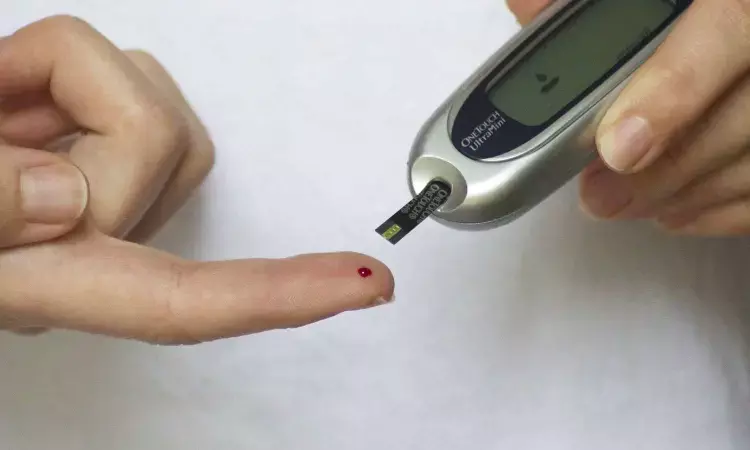- Home
- Medical news & Guidelines
- Anesthesiology
- Cardiology and CTVS
- Critical Care
- Dentistry
- Dermatology
- Diabetes and Endocrinology
- ENT
- Gastroenterology
- Medicine
- Nephrology
- Neurology
- Obstretics-Gynaecology
- Oncology
- Ophthalmology
- Orthopaedics
- Pediatrics-Neonatology
- Psychiatry
- Pulmonology
- Radiology
- Surgery
- Urology
- Laboratory Medicine
- Diet
- Nursing
- Paramedical
- Physiotherapy
- Health news
- Fact Check
- Bone Health Fact Check
- Brain Health Fact Check
- Cancer Related Fact Check
- Child Care Fact Check
- Dental and oral health fact check
- Diabetes and metabolic health fact check
- Diet and Nutrition Fact Check
- Eye and ENT Care Fact Check
- Fitness fact check
- Gut health fact check
- Heart health fact check
- Kidney health fact check
- Medical education fact check
- Men's health fact check
- Respiratory fact check
- Skin and hair care fact check
- Vaccine and Immunization fact check
- Women's health fact check
- AYUSH
- State News
- Andaman and Nicobar Islands
- Andhra Pradesh
- Arunachal Pradesh
- Assam
- Bihar
- Chandigarh
- Chattisgarh
- Dadra and Nagar Haveli
- Daman and Diu
- Delhi
- Goa
- Gujarat
- Haryana
- Himachal Pradesh
- Jammu & Kashmir
- Jharkhand
- Karnataka
- Kerala
- Ladakh
- Lakshadweep
- Madhya Pradesh
- Maharashtra
- Manipur
- Meghalaya
- Mizoram
- Nagaland
- Odisha
- Puducherry
- Punjab
- Rajasthan
- Sikkim
- Tamil Nadu
- Telangana
- Tripura
- Uttar Pradesh
- Uttrakhand
- West Bengal
- Medical Education
- Industry
What are optimal glycemic targets associated with reduced dementia risk in older people with type 2 diabetes?

The risk for dementia is found to be the greatest among elderly type 2 diabetic people who had cumulative HbA1c concentrations of 9% or more, suggests a study from Australia recently published in JAMA Neurology.
Although type 2 diabetes is associated with increased dementia risk, it is unclear whether glycemic control mediates this risk in people in middle to later life. Observational studies have reported that hyperglycemia and duration of diabetes are associated with increased dementia risk. However, studies of interventions with aggressive glycemic targets suggest that attempting to achieve strict glycemic control may increase the risk of harm, including death, particularly in older patients.
The harm associated with intensive glucose control has led the American Diabetes Association, American Geriatrics Society, Endocrine Society, and US Department of Veterans Affairs to recommend that glycemic targets for people in middle to later life be individualized and to consider risk of hypoglycemia, number and severity of comorbidities, functional independence, cognitive impairment, and life expectancy. Each of these organisations differs with regard to the exact therapeutic target recommended and encourages this to be developed based on a person’s individual circumstances.
To help inform patient-centered glycemic target setting, it is essential to understand the contribution of glycemic control to dementia risk. Long-term glycemic control, measured using cumulative glycemic exposure via multiple glycated hemoglobin (HbA1c) measurements over time, provides a more nuanced understanding of glycemic control than mean HbA1c concentrations.
Moran et al in their study aimed to examine the associations between cumulative exposure to various ranges of HbA1c with dementia risk across sex and racial and ethnic groups and explore the association of current therapeutic glycemic targets with dementia risk.
The authors found that greater cumulative exposure to HbA1c concentrations in the range of 6% to less than 7% and 7% to less than 8% was associated with lower hazard of dementia. Importantly, they observed no significant change in hazard for individuals with HbA1c concentrations in the range of relaxed glycemic control recommended by the American Geriatrics Society and US Department of Veterans Affairs for older patients with multiple comorbidities, poor health, or limited life expectancy. Although there were subtle sex and race and ethnicity differences in the dementia hazard associated with cumulative exposure to increasing HbA1c concentrations, greater time spent in commonly recommended glycemic targets was associated with lower dementia hazard across all sexes and racial and ethnic groups.
“In this cohort study of a large sample of older people with type 2 diabetes, we found that increased exposure to HbA1c concentrations greater than or equal to 9% was associated with the greatest hazard of dementia. Additional work is needed to examine whether the observational associations we report are causal and are seen in other groups”, conclude the authors.
Reference
Moran C, Lacy ME, Whitmer RA, et al. Glycemic Control Over Multiple Decades and Dementia Risk in People With Type 2 Diabetes. JAMA Neurol. Published online April 17, 2023. doi:10.1001/jamaneurol.2023.0697
MBBS, DrNB Neurosurgery
Krishna Shah, MBBS, DrNB Neurosurgery. She did her MBBS from GMC, Jamnagar, and there after did direct 6 Year DrNB Neurosurgery from Sir Ganga Ram Hospital, Delhi. Her interests lie in Brain and Spine surgery, Neurological disorders, minimally invasive surgeries, Endoscopic brain and spine procedures, as well as research.
Dr Kamal Kant Kohli-MBBS, DTCD- a chest specialist with more than 30 years of practice and a flair for writing clinical articles, Dr Kamal Kant Kohli joined Medical Dialogues as a Chief Editor of Medical News. Besides writing articles, as an editor, he proofreads and verifies all the medical content published on Medical Dialogues including those coming from journals, studies,medical conferences,guidelines etc. Email: drkohli@medicaldialogues.in. Contact no. 011-43720751


